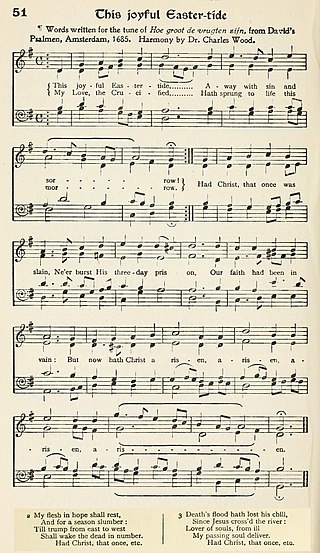
"Gloria in excelsis Deo" is a Christian hymn known also as the Greater Doxology and the Angelic Hymn/Hymn of the Angels. The name is often abbreviated to Gloria in Excelsis or simply Gloria.

"Christ the Lord Is Risen Today" is a Christian hymn associated with Easter. Most of the stanzas were written by Charles Wesley, and the hymn appeared under the title "Hymn for Easter Day" in Hymns and Sacred Poems by Charles and John Wesley in 1739. The hymn eventually became well known for the "Alleluia" sung as a melisma after each line, which was added by an unknown author, probably to fit the commonly used hymn tune, "Easter Hymn". It remains a traditional processional hymn on Easter Sunday.

"Jesus Christ Is Risen Today" is a Christian hymn. It was initially written in the 14th century as a Bohemian Latin hymn titled "Surrexit Christus hodie". It is an Easter hymn referring to the Resurrection of Jesus and based on Matthew 28:6, Acts 2:32, 1 Peter 3:18 and Revelation 1:17-18.
Phos Hilaron is an ancient Christian hymn originally written in Koine Greek. Often referred to in the Western Church by its Latin title Lumen Hilare, it has been translated into English as O Gladsome Light. It is one of the earliest known Christian hymns recorded outside of the Bible that is still in use today. The hymn is part of vespers in the Eastern Orthodox Church and the Byzantine Rite of the Catholic Church, and also included in some Anglican liturgies and Lutheran hymnals.

Hymns Ancient and Modern is a hymnal in common use within the Church of England, a result of the efforts of the Oxford Movement. The hymnal was first published in 1861. The organization publishing it has now been formed into a charitable trust, Hymns Ancient and Modern Ltd, and As of 2022 it publishes a wide range of hymnals as well as other theological and religious books and magazines, under imprints including the acquired publishers Canterbury Press and SCM Press.
Archer Thompson Gurney (1820–1887) was a Church of England clergyman and hymnodist.
"O Valiant Hearts" is a hymn remembering the fallen of the First World War. It often features prominently in annual Remembrance Day services in the United Kingdom and the British Commonwealth.

"Thine Be the Glory, Risen Conquering Son", also titled "Thine Is the Glory", is a Christian hymn for Easter, written by the Swiss Protestant minister, Edmond Budry (1854–1932), and set to the tune of the chorus "See, the Conqu'ring hero comes" from the third section of Handel's oratorio Judas Maccabaeus. The hymn is sometimes sung at weddings or funerals.

"All Creatures of Our God and King" is an English Christian hymn by William Henry Draper, based on a poem by St. Francis of Assisi. It was first published in a hymn book in 1919.

"Gelobt sei Gott im höchsten Thron" is a hymn for Easter in 20 stanzas in German by Michael Weiße, widely known with a later melody by Melchior Vulpius. Shortened, it is part of current Protestant and Catholic German hymnals.

"Christ ist erstanden" is a German Easter hymn, and is possibly the oldest Christian liturgical German song. It has inspired the music of numerous composers, such as Ludwig Senfl and Heinrich Schütz, as well as modern composers such as Oskar Gottlieb Blarr and Enjott Schneider, and has appeared in 45 hymnals, including the current German Catholic and Protestant hymnals. Translations and paraphrases include a version by Catherine Winkworth which has appeared in 231 hymnals. "Christ ist erstanden" also inspired Martin Luther to write "Christ lag in Todes Banden", deriving the melody from it.
Robert Hall Baynes was an Anglican priest, a hymnodist and a hymn writer. He was editor of the Lyra Anglicana, which was among the most influential hymnals of the Oxford Movement in the 1860s and 1870s, having a relatively broad selection of Anglican authors.
"Christ the Lord Is Risen Again!" is a German Christian hymn published by Michael Weiße in 1531 based on an earlier German hymn of a very similar name. It was translated into English in 1858 by Catherine Winkworth.

"This joyful Eastertide" is an 1894 Easter carol. The words are by George Ratcliffe Woodward, the tune is from the Netherlands (1624), and the 1894 harmonisation is by Charles Wood.
"At the Name of Jesus" is a hymn with lyrics written by Caroline Maria Noel. It was first published in 1870, in an expanded version of Noel's collection The Name of Jesus and Other Verses for the Sick and Lonely. At the time, Noel herself experienced chronic illness, which persisted until her death. The hymn has become popular across Christian denominations, and appears in over 200 hymnals. It has been set to many different tunes, including compositions by William Henry Monk, Ralph Vaughan Williams and Michael Brierley.
Francis Pott was an English hymnwriter and Anglican priest. He is noted as the author or translator of a number of popular Christian hymns including "Angel Voices, Ever Singing" and "The Strife is O'er, the Battle Done". His hymns are an established part of the Anglican church music repertoire and commonly feature in hymnals such as The New English Hymnal.
"The Strife is O'er, the Battle Done" is a Christian hymn that is traditionally sung at Easter to celebrate the Resurrection of Jesus. It was originally a 17th-century Latin hymn, "Finita iam sunt proelia"; the popular English-language version is an 1861 translation by the English hymnwriter Francis Pott.

"Angel Voices, Ever Singing" is an English Christian hymn. It was written in 1861 by the Church of England vicar Francis Pott (1832–1909). It was written for the dedication of an organ.

"I Know That My Redeemer Lives" is an English Christian Easter hymn in long metre by Samuel Medley. It was published in 1775 and is written for Easter Sunday.











